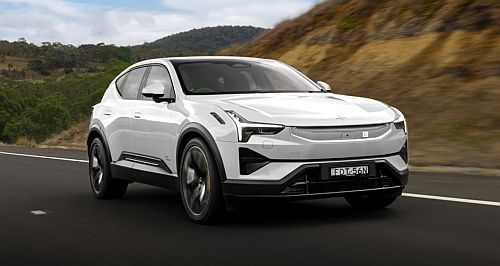Polestar to maintain ‘individual market presence’

WITH a fast-growing number of Chinese marques entering the Australian market – including Polestar part-parent Geely – the opportunity to leverage or even centralised the stronger partner’s operations is one many would assume makes business sense.
But in speaking with GoAuto Premium at the local launch of the Polestar 3 in Tasmania this week, Polestar Australia managing director Scott Maynard said any such collaboration is not on the table, with the duo wishing to maintain their individuality at a market level.
“At a market level, we need to make sure we have a very distinctive brand identity, and that our brand identity ties back to our roots in Sweden, which is where our chassis tune comes from,” he explained.
“Whilst we might have access to a broader parts bin – and the investment that comes from the Geely group – Polestar’s brand identity in Australia will remain individual.”
Mr Maynard said Polestar would double-down on its relationship with Volvo, entering dealerships as it moves toward a bricks-and-mortar sales model and utilising the Swedish marque’s capacity in parts supply and storage, pre-delivery, and vehicle servicing.
“It’s with Volvo, and it will stay there,” he insisted.
“Even with the Polestar 4, which draws more commonality with the Geely product, it is stocked and supplied through Volvo and will be serviced via the Volvo network as well.
“As to whether that will change in the future, I would never say never. But I think that when a brand (Polestar) has worked so hard to carve out its sustainability credentials and its totally individual design that it won’t want to trade on that.
“We’re essentially performing in different ways and in different market segments, so I don’t see that (partnership) being a short-term goal.”
Mr Maynard said that Polestar is expected to grow its sales volume considerably over the next 12 to 18 months as new models, including the Polestar 3 and 4, attract a more diverse buyer set.
“The new product will open the door to that (higher sales volumes). The Polestar 4 in particular is expected to be a bit of a winner in terms of volume, and likely to catapult to the top of the pops in terms of our highest selling vehicle,” he predicted.
“And with the improvement in production and the diversity of production plants across the world – and the opening up of new markets – the portfolio that we have got now will absolutely get us back to black, which has been so hard to do with just one car.”
In markets, including Australia and the United States, where SUV models are more popular than passenger sedans, it is expected Polestar 3 and 4 models will come into their own, bringing with them the sales volume required to return the OEM to profit.
“A huge investment has been made in setting up the brand in exactly the right way. Establishing the kind of sustainability credentials that the brand now has, and that doesn’t come cheaply – it is a more expensive way of doing things,” he said.
“But now that is established, and the protocols are set, the economies of scale will come into play as the brand continues on that track; and the addition of volume through models that sit in more popular market segments – like the Medium and Large SUV – will then be the kicker.”
The Polestar 3 goes on sale locally from this month (September) priced from $118,420 plus on-road costs.